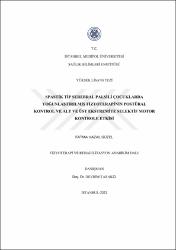| dc.contributor.advisor | Tarakçı, Devrim | |
| dc.contributor.author | Güzel, Fatma Hazal | |
| dc.date.accessioned | 2022-01-21T06:17:31Z | |
| dc.date.available | 2022-01-21T06:17:31Z | |
| dc.date.issued | 2021 | en_US |
| dc.date.submitted | 2021-08-02 | |
| dc.identifier.citation | Güzel, F. H. (2021). Spastik tip serebral palsili çocuklarda yoğunlaştırılmış fizyoterapinin postüral kontrol ve alt ve üst ekstremite selektif motor kontrole etkisi. (Yayınlanmamış yüksek lisans tezi). İstanbul Medipol Üniversitesi Sağlık Bilimleri Enstitüsü, İstanbul. | en_US |
| dc.identifier.uri | https://hdl.handle.net/20.500.12511/8871 | |
| dc.description.abstract | Çalışmamızın amacı, spastik tip SP tanılı olgularda 2 haftalık Nörogelişimsel Tedavi (NGT) temelli ve aktif katılımlı yoğunlaştırılmış fizyoterapinin postüral kontrol ve alt ve üst ekstremite selektif motor kontrol üzerine etkisinin araştırılmasıdır. Çalışmaya yaşları 4-8 yıl arasında değişen, Kaba Motor Fonksiyon Sınıflama Sistemi (KMFSS)'ne göre seviyeleri II, III ve IV olan 30 spastik tip SP'li olgu dahil edildi. Olgular, iki gruba randomize edildi. Deney grubuna, 2 hafta boyunca haftada 6 gün, günde 2'şer seans ve seans süreleri 50 dk olmak üzere yoğunlaştırılmış NGT temelli ve aktif katılımlı fizyoterapi programı uygulandı. Kontrol grubuna ise, 2 hafta boyunca haftada 3 gün, günde 1 kez ve seans süreleri 45 dk olmak üzere konvansiyonel fizyoterapi programı uygulandı. Gruplara 2 haftalık tedavi öncesi ve sonrası Oturmada Postüral Kontrol Ölçümü-Fonksiyon (OPKÖ-Fonksiyon) bölümü, Alt Ekstremite Selektif Kontrol Değerlendirme Skalası (SCALE), Üst Ekstremite Selektif Kontrol Skalası (SCUES), Modifiye Ashworth Skalası (MAS), Kaba Motor Fonksiyon Sınıflama Sistemi (KMFSS), Kaba Motor Fonksiyon Ölçütü-88 (KMFÖ-88), El Becerileri Sınıflandırma Sistemi (EBSS), Çocuklar İçin Yaşam Kalitesi Ölçeği (ÇİYKÖ) uygulandı. Tedavi sonrası iki grup arasında OPKÖ-Fonksiyon, SCALE, SCUES, alt ekstremite ve üst ekstremite MAS, KMFÖ-88 ve ÇİYKÖ skorlarında deney grubu lehine anlamlı değişim elde edildi (p<0.05), Ancak tedavi sonrası iki grup arasında KMFSS ve EBSS seviyeleri değişiminde anlamlı fark yoktu (p>0.05). Sonuç olarak çalışmamız spastik tip SP'li çocuklarda NGT temelli yoğunlaştırılmış fizyoterapinin oturmada postüral kontrol fonksiyonlarına, alt ve üst ekstremite selektif motor kontrol hareketlerine, spastisiteye, kaba motor fonksiyon ölçümü puanlarına, yaşam kalitesine anlamlı etkisi olduğunu kanıtlamıştır. | en_US |
| dc.description.abstract | The aim of our study is to investigate the effect of 2-week Neurodevelopmental Treatment (NDT)-based and intensive physiotherapy with active participation on postural control and selective motor control of the lower and upper extremities in patients with a diagnosis of spastic type CP. 30 patients with spastic type CP, aged between 4 and 8 years, with levels II, III and IV according to Gross Motor Function Classification System (GMFCS) were included in the study. The cases were randomized into 2 groups. NDT-based and active participation intensive physiotherapy program was applied to the experimental group for 2 weeks, 6 days a week, 2 sessions a day, and a session duration of 50 minutes. In the control group, a conventional physiotherapy program was applied for 2 weeks, 3 days a week, once a day, with a session duration of 45 minutes. Before and after the 2-week therapy Seated Postural Control Measure-Function (SPCM-Function) section, Selective Control Assessment of the Lower Extremity (SCALE), Selective Control of the Upper Extremity Scale (SCUES), Modified Ashworth Scale (MAS), Gross Motor Function Classification System (GMFCS), Gross Motor Function Measure-88 (GMFM-88), Manual Ability Classification System (MACS), Pediatric Quality of Life Inventory (PedsQL) were applied to the groups. After therapy, there was a significant change in favor of the experimental group in the SPCM-Function, SCALE, SCUES, lower extremity and upper extremity MAS, GMFM-88 and PedsQL scores between the two groups (p<0.05). However, there was no significant difference in the change of GMFCS and MACS levels between the two groups after therapy (p>0.05). In conclusion, our study has proven that NDT-based intensive physiotherapy has a significant effect on postural control functions in sitting, selective motor control movements of lower and upper extremity, spasticity, gross motor function measurement scores, quality of life in children with spastic type CP. | en_US |
| dc.language.iso | tur | en_US |
| dc.publisher | İstanbul Medipol Üniversitesi Sağlık Bilimleri Enstitüsü | en_US |
| dc.rights | info:eu-repo/semantics/openAccess | en_US |
| dc.subject | Nörogelişimsel Tedavi | en_US |
| dc.subject | Postüral Kontrol | en_US |
| dc.subject | Selektif Motor Kontrol | en_US |
| dc.subject | Serebral Palsi | en_US |
| dc.subject | Yoğunlaştırılmış Terapi | en_US |
| dc.subject | Neurodevelopmental Treatment | en_US |
| dc.subject | Postural Control | en_US |
| dc.subject | Selective Motor Control | en_US |
| dc.subject | Cerebral Palsy | en_US |
| dc.subject | Intensive Therapy | en_US |
| dc.title | Spastik tip serebral palsili çocuklarda yoğunlaştırılmış fizyoterapinin postüral kontrol ve alt ve üst ekstremite selektif motor kontrole etkisi | en_US |
| dc.title.alternative | The effect of intensive physiotherapy on postural control and lower and upper extremity selective motor control in children with spastic type cerebral palsy | en_US |
| dc.type | masterThesis | en_US |
| dc.department | İstanbul Medipol Üniversitesi, Sağlık Bilimleri Enstitüsü, Fizyoterapi ve Rehabilitasyon Ana Bilim Dalı | en_US |
| dc.relation.publicationcategory | Tez | en_US |


















